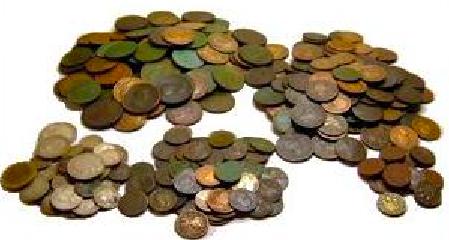Skip over navigation



Or search by topic
Number and algebra
Geometry and measure
Probability and statistics
Working mathematically
Advanced mathematics
For younger learners
Coins (2)
Age 7 to 11
Challenge Level 





- Problem
- Getting Started
- Teachers' Resources
Coins (2)

Most countries have their own currency - coins and notes.
How many different values of coins and/or notes do you have in your country?
Let's take the USA as an example - using dollars \$ and cents ¢.
One dollar is equal to 100 cents.
Coins: 1 ¢, 5 ¢ , 10 ¢ , 25 ¢ , \$1
Banknotes: \$1 , \$5 , \$10 , \$20, \$50 , \$100 .
For another example let's take India - using Rupee ₹ and Paise .
.
One Rupee is equal to 100 Paise.
Coins 50 & ₹1, ₹2, ₹5, ₹10,
& ₹1, ₹2, ₹5, ₹10,
Notes ₹5, ₹10, ₹20, ₹50, ₹100, ₹500, ₹1000
Using American currency
What is the smallest number of notes and coins (and what are they) which make a total of 12 dollars 83 cents?
What is the largest number of different notes and coins you can use to make 12 dollars 83 cents?
Using Indian currency
What is the smallest number of notes and coins (and what are they) which make a total of ₹1260 ?
What is the largest number of different notes and coins you can use to make ₹1260 ?
How many different values of coins and/or notes do you have in your country?
Let's take the USA as an example - using dollars \$ and cents ¢.
One dollar is equal to 100 cents.
Coins: 1 ¢, 5 ¢ , 10 ¢ , 25 ¢ , \$1
Banknotes: \$1 , \$5 , \$10 , \$20, \$50 , \$100 .
For another example let's take India - using Rupee ₹ and Paise
 .
.One Rupee is equal to 100 Paise.
Coins 50
 & ₹1, ₹2, ₹5, ₹10,
& ₹1, ₹2, ₹5, ₹10,Notes ₹5, ₹10, ₹20, ₹50, ₹100, ₹500, ₹1000
Using American currency
What is the smallest number of notes and coins (and what are they) which make a total of 12 dollars 83 cents?
What is the largest number of different notes and coins you can use to make 12 dollars 83 cents?
Using Indian currency
What is the smallest number of notes and coins (and what are they) which make a total of ₹1260 ?
What is the largest number of different notes and coins you can use to make ₹1260 ?
Photograph Acknowledgement
http://www.psdetecting.com/
http://www.psdetecting.com/
Why do this problem?
This activity gives the pupils opportunities for exploring the relationship between different denominations of currency. It also offers a context in which to become more fluent in addition and number awareness.
Possible approach
It would be good to use your native currency first and explore making various amounts of money. The activity can then be presented to the pupils just as it is.
The second part of each currency question will probably need some discussion so it would be good to allow pupils to work in small groups. Give them time to discuss their solutions as a whole class, particularly if they differ!
These were the coins available: 1 para, 5 para, 10 para, 20 para and 40 para; 1 Kurus, 2 Kurus, 5 Kurus, 10 Kurus, 20 Kurus, 25 Kurus, 100 Kurus and 500 Kurus.
So you could ask questions like:
What is the smallest number of coins needed (and what are they) to make 1260 Kurus 60 paras?
What is the largest number of different notes and coins you can use to make 1260 Kurus 60 paras?
The second part of each currency question will probably need some discussion so it would be good to allow pupils to work in small groups. Give them time to discuss their solutions as a whole class, particularly if they differ!
Key questions
How sure are you that this is the smallest number of notes and coins?
How have you gone about trying to find the highest number of different notes and coins?
How have you gone about trying to find the highest number of different notes and coins?
Possible extension
It would be good to look at parts of Europe and Africa in the 19th century that used a currency made up of para and Kurus. 40 paras made a Kurus.These were the coins available: 1 para, 5 para, 10 para, 20 para and 40 para; 1 Kurus, 2 Kurus, 5 Kurus, 10 Kurus, 20 Kurus, 25 Kurus, 100 Kurus and 500 Kurus.
So you could ask questions like:
What is the smallest number of coins needed (and what are they) to make 1260 Kurus 60 paras?
What is the largest number of different notes and coins you can use to make 1260 Kurus 60 paras?
Possible support
Wherever possible, it would be helpful to have real coins for learners to handle as they work on this task.You may also like
Christmas Shopping
Vera is shopping at a market with these coins in her purse. Which things could she give exactly the right amount for?
Buying a Balloon
Lolla bought a balloon at the circus. She gave the clown six coins to pay for it. What could Lolla have paid for the balloon?

